Fig. 1.
Effect of 5 consecutive days of restraint stress on PPI. Values shown are means ± SEMs. For all groups, n = 9–11. The average of all prepulse stimulus intensities (76, 82, 85, and 88 dB) is shown as Percent Prepulse Inhibition. Rats were restrained for 2 hours/day for 5 consecutive days, or were handled briefly and returned to the home cage. PPI was assessed 30 minutes after restraint termination on days 1, 3, and 5. On day 1, restraint did not alter PPI. On day 3, restraint significantly attenuated the increase in PPI caused by repeated testing (*p < 0.001 vs. No Restraint on day 3). On day 5, there was a trend for restraint to attenuate the increase in PPI caused by repeated testing.

